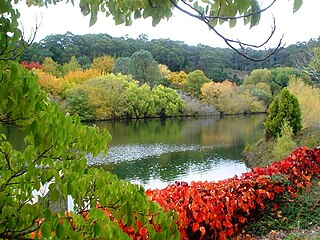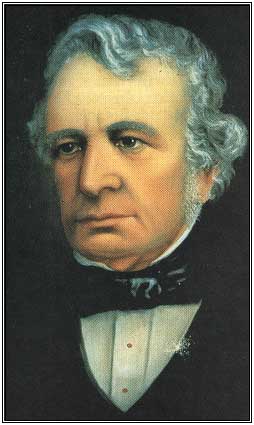
The New York Botanical Garden (NYBG) is a botanical garden at Bronx Park in the Bronx, New York City. Established in 1891, it is located on a 250-acre (100 ha) site that contains a landscape with over one million living plants; the Enid A. Haupt Conservatory, a greenhouse containing several habitats; and the LuEsther T. Mertz Library, which contains one of the world's largest collections of botany-related texts. As of 2016, over a million people visit the New York Botanical Garden annually.

Baron Sir Ferdinand Jacob Heinrich von Mueller, was a German-Australian physician, geographer, and most notably, a botanist. He was appointed government botanist for the then colony of Victoria (Australia) by Governor Charles La Trobe in 1853, and later director of the Royal Botanic Gardens, Melbourne. He also founded the National Herbarium of Victoria. He named many Australian plants.

Kirstenbosch is an important botanical garden nestled at the eastern foot of Table Mountain in Cape Town. The garden is one of 10 National Botanical Gardens covering five of South Africa's six different biomes and administered by the South African National Biodiversity Institute (SANBI). Prior to 1 September 2004, the institute was known as the National Botanical Institute.

Royal Botanic Gardens Victoria are botanic gardens across two sites–Melbourne and Cranbourne.

The Royal Botanic Garden, Sydney is a heritage-listed major 30-hectare (74-acre) botanical garden, event venue and public recreation area located at Farm Cove on the eastern fringe of the Sydney central business district, in the City of Sydney local government area of New South Wales, Australia.

First opened in 1977, the crescent-shaped Mount Lofty Botanic Garden is situated on 100 hectares on the eastern slopes of Mount Lofty in the Adelaide Hills east of Adelaide in South Australia. The cooler, wetter location suits plants from temperate climates which are difficult to grow on the Adelaide Plains. Amongst the native Australian flora there are tree ferns, as well as exotic cultivated plants from cool climates including Rhododendron and Magnolia and the National Species Rose Collection. The Mount Lofty Botanic Garden, together with the Adelaide and Wittunga Botanic Gardens, is administered by the Botanic Gardens of South Australia, a State Government statutory authority.

Nancy Tyson Burbidge was an Australian systemic botanist, conservationist and herbarium curator.

The National Herbarium of Victoria is one of Australia's earliest herbaria and the oldest scientific institution in Victoria. Its 1.5 million specimens of preserved plants, fungi and algae—collectively known as the State Botanical Collection of Victoria—comprise the largest herbarium collection in Australia and Oceania.

Moritz Richard Schomburgk, generally known as Richard Schomburgk, was a German botanist and curator of the Adelaide Botanic Garden.

Kew Gardens is a botanic garden in southwest London that houses the "largest and most diverse botanical and mycological collections in the world". Founded in 1840, from the exotic garden at Kew Park, its living collections include some of the 27,000 taxa curated by Royal Botanic Gardens, Kew, while the herbarium, one of the largest in the world, has over 8.5 million preserved plant and fungal specimens. The library contains more than 750,000 volumes, and the illustrations collection contains more than 175,000 prints and drawings of plants. It is one of London's top tourist attractions and is a World Heritage Site.
Joseph Whittaker was a British botanist who visited South Australia in 1839. Whittaker has 300 plants from that trip in Kew Gardens and a large collection of pressed British plants in Derby Museum and Art Gallery.

Maurice William Holtze born in the Kingdom of Hanover, was a botanist who established Darwin's Botanical Gardens in Fannie Bay, Darwin in 1878. When he left to take charge of Adelaide's Botanic Garden in 1891, his son Nicholas was appointed curator of the Darwin Botanical Gardens in his place.

The State Herbarium of South Australia, sometimes called the South Australian Herbarium, and having the herbarium code, AD, is located in Adelaide, South Australia. It is one of several State and Commonwealth herbaria in Australia. The Department for Environment and Water is the state agency which is responsible for the Herbarium, but the Board of the Botanic Gardens and State Herbarium is charged with its establishment and maintenance.

George William Francis was an English horticulturalist and science writer. He migrated to the colony of South Australia in 1849 and became the first director of the Adelaide Botanic Garden in 1860.

The LuEsther T. Mertz Library is located at the New York Botanical Garden (NYBG) in the Bronx, New York City. Founded in 1899 and renamed in the 1990s for LuEsther Mertz, it is the United States' largest botanical research library, and the first library whose collection focused exclusively on botany.

The National Herbarium of New South Wales was established in 1853. The Herbarium has a collection of more than 1.4 million plant specimens, making it the second largest collection of pressed, dried plant specimens in Australia, including scientific and historically significant collections and samples of Australian flora gathered by Joseph Banks and Daniel Solander during the voyage of HMS Endeavour in 1770.
Glenside Hospital, as it was known from 1967, previously the Public Colonial Lunatic Asylum of South Australia, Parkside Lunatic Asylum and Parkside Mental Hospital, was a complex of buildings used as a psychiatric hospital in Glenside, South Australia.
The Australasian Virtual Herbarium (AVH) is an online resource that allows access to plant specimen data held by various Australian and New Zealand herbaria. It is part of the Atlas of Living Australia (ALA), and was formed by the amalgamation of Australia's Virtual Herbarium and NZ Virtual Herbarium. As of 12 August 2014, more than five million specimens of the 8 million and upwards specimens available from participating institutions have been databased.
Hansjörg Eichler was a German-born botanist, educated in Europe, who worked in Europe and Australia, and whose greatest contribution was to Australian botany.

The Santos Museum of Economic Botany, located in the Adelaide Botanic Gardens, displays a permanent collection exhibiting the practical, medicinal and economic use of plant materials.

























